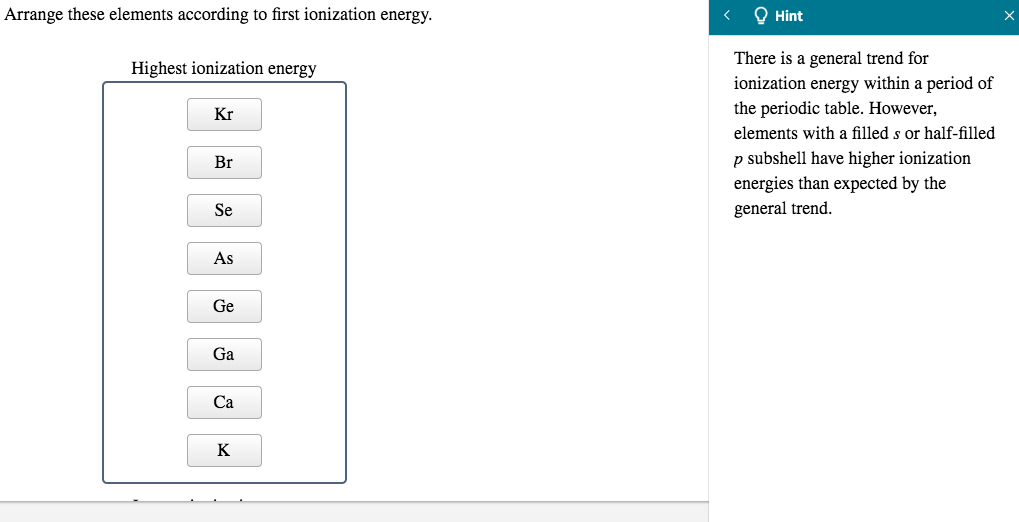

Hence, oxygen has lower Δ i H than nitrogen.įluorine contains one electron and one proton more than oxygen. As a result, the energy required to remove the fourth 2 p-electron from oxygen is less as compared to the energy required to remove one of the three 2 p-electrons from nitrogen. This results in increased electron-electron repulsion in oxygen atom. However, in oxygen, two of the four 2 p-electrons of oxygen occupy the same 2 p-orbital. (ii) In nitrogen, the three 2 p-electrons of nitrogen occupy three different atomic orbitals. Hence, beryllium has higher Δ i H than boron. Therefore, more energy is required to remove a 2 s-electron of beryllium than that required to remove a 2 p-electron of boron. Now, 2 s-electrons are more strongly attached to the nucleus than 2 p-electrons. (i)ĝuring the process of ionization, the electron to be removed from beryllium atom is a 2 s-electron, whereas the electron to be removed from boron atom is a 2 p-electron. Some of its isoelectronic species are Br – ion (35 +ġ = 36 electrons), Kr (36 electrons), and Sr 2+ ion (38 – Thus, the species isoelectronic with it will also have 36 electrons. Some of its isoelectronic species are F – ion (9 + 1 Thus, the species isoelectronic with it will also have 10 electrons. (iii) Mg 2+ ion has 12 – 2 = 10 electrons. Species are S 2– ion (16 + 2 = 18 electrons), Cl – Of its isoelectronic species are Na + ion (11 – 1 =ġ0 electrons), Ne (10 electrons), O 2– ion (8 + 2 =ġ0 electrons), and Al 3+ ion (13 – 3 = 10 electrons). The species isoelectronic with it will also have 10 electrons. The same number of electrons are called isoelectronic species. Whereas the atomic radius of F atom is 64 pm. ForĮxample, the ionic radius of F – ion is 136 pm, The parent atom resulting in an increased repulsion among theĮlectrons and a decrease in the effective nuclear charge. This isīecause an anion has the same nuclear charge, but more electrons than Other hand, an anion is larger in size than its parent atom. Is 95 pm, whereas the atomic radius of Na atom is 186 pm. Thus, a cation is smaller than the parent

The ionic radii can be calculatedīy measuring the distances between the cations and anions in ionicįormed by removing an electron from an atom, the cation has fewerĮlectrons than the parent atom resulting in an increase in theĮffective nuclear charge. Thus, the covalent radius of chlorine is taken as. For example, theĭistance between two chlorine atoms in chlorine molecule is 198 pm. Together by a single bond in a covalent molecule. Measured as the distance between two atoms when they are found Thus, the metallic radius of copper is taken as. Internuclear distance between two adjacent copper atoms in solidĬopper is 256 pm. Separating the metal cores in the metallic crystal. Metallic radius is calculated as half the internuclear distance The element is a non-metal, then it refers to the covalent radius. If the element isĪ metal, then the atomic radius refers to the metallic radius, and if Of the periodic table should have 32 elements. Thus, 16 orbitals can accommodate a maximum of 32 electrons. Principle, each orbital can accommodate a maximum of 2 electrons. Therefore, there are a total of sixteen (1 + 7 + 5 +ģ = 16) orbitals available.

Has seven orbitals, 5 d has five orbitals, and 6 p has Period, electrons can be filled in only 6 s, 4 f, 5 d,Īnd 6 p subshells. The energy of the 6 d subshell isĮven higher than that of the 7 s subshell. Principle, electrons are added to different orbitals in order of For n = 6,Īzimuthal quantum number ( l) can have values of 0, 1, 2, 3, 4. Each periodīegins with the filling of principal quantum number ( n). Quantum number ( n) for the outermost shells. Of the elements, a period indicates the value of the principal


 0 kommentar(er)
0 kommentar(er)
